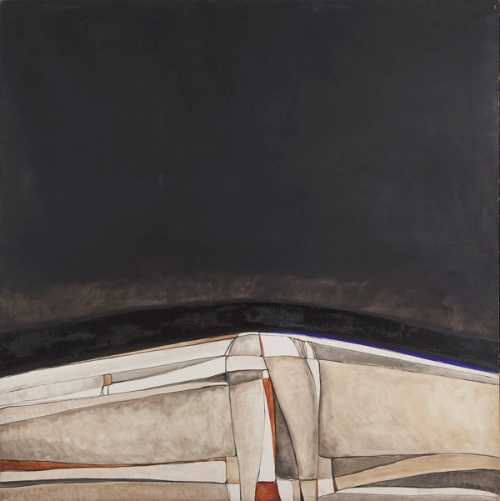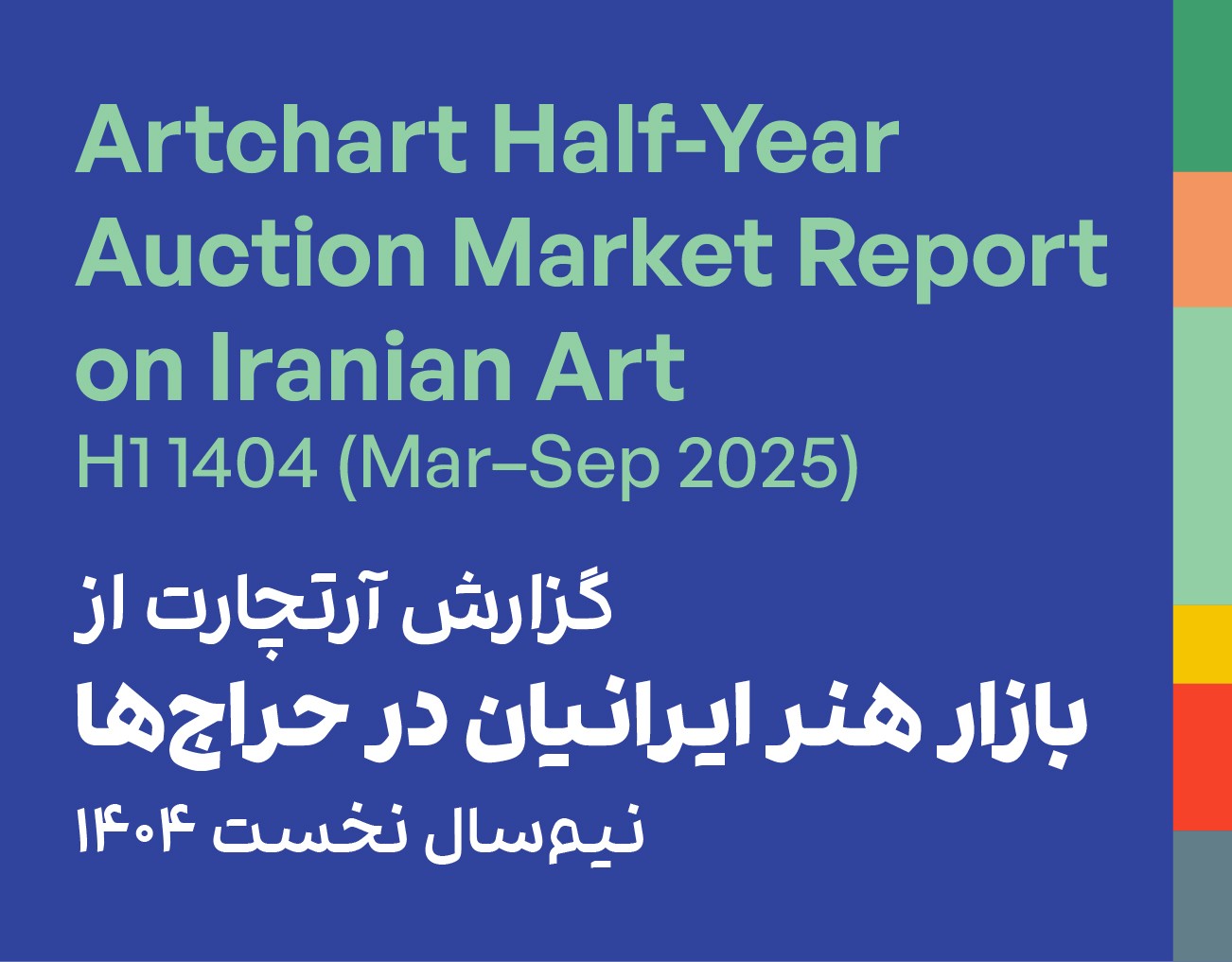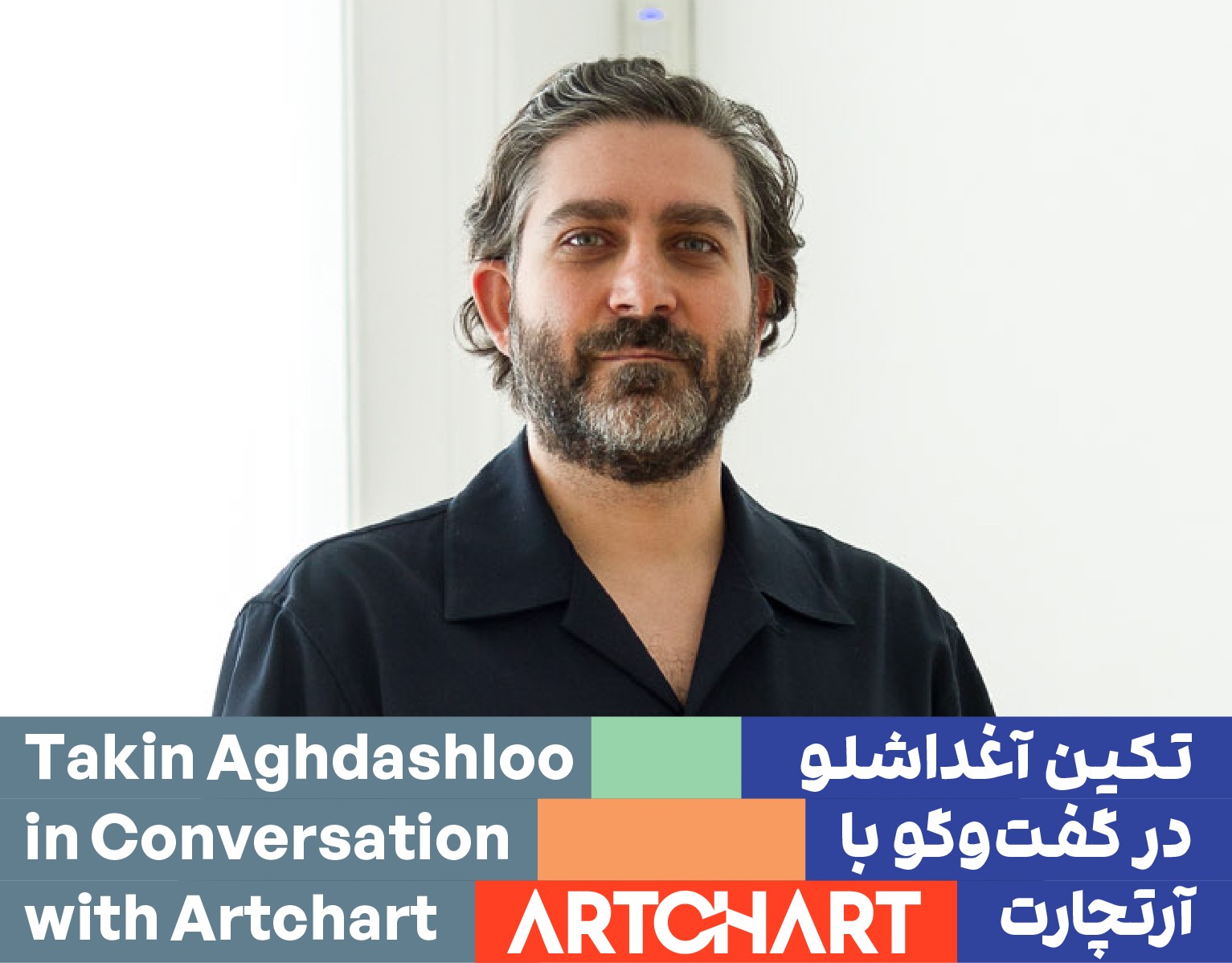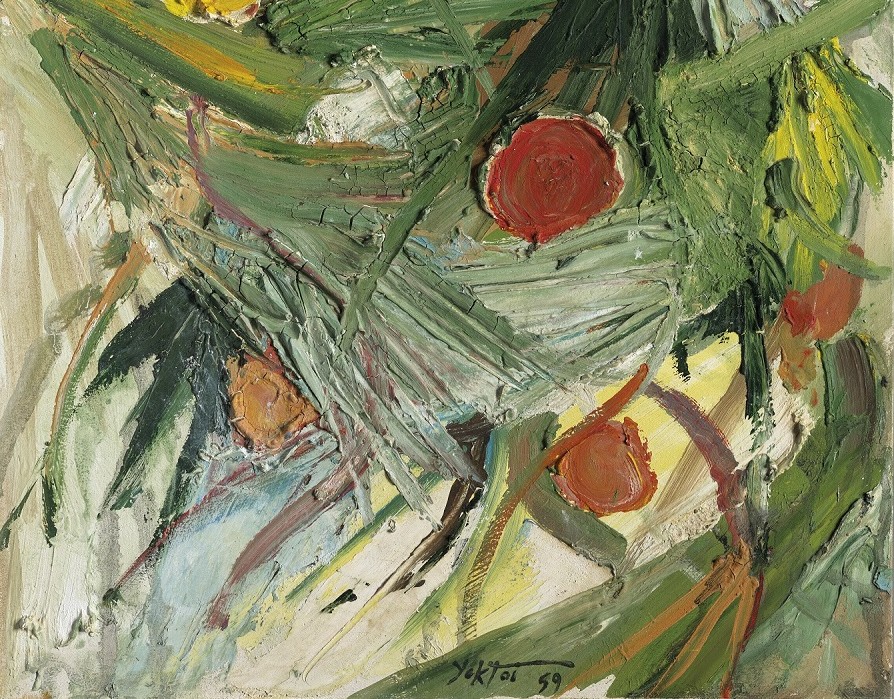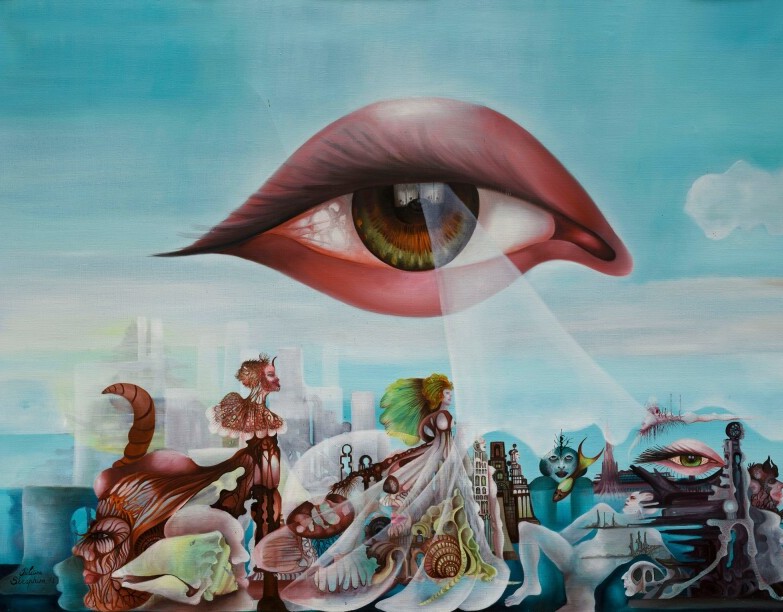About Sirak Melkonian
Sirak Melkonian is a self-taught Iranian-Armenian artist, and a painter of abstract landscapes. At the age of fifteen, he participated in the group painting exhibition of the Armenian Cultural Association called "Mshakuyt" and then, in 1950, he attended the annual exhibition of the Iran-USSR Society, Tehran.
Melkonian worked closely with Marco Grigorian and got to know the art nouveau movement through the magazines and newspapers that Marco sent from Italy. He held his first solo exhibition in 1957 at the Estetic Gallery, Tehran. He received "The Imperial Court Prize" at the first Tehran Biennale and the "Special Award" at the "Contemporary Iranian Artists' Show" in the Iran-America Society. Since then, his works have been displayed alternately in group and individual exhibitions in Iran, America, Canada and Europe. In 1974, he founded the "Azad Group of Painters and Sculptors" with the cooperation of several modern painters and presented his works in domestic and foreign exhibitions of this group. One of the most important exhibitions of Melkonian was in Galerie Herve Odermatt in Paris.
In his early figurative paintings, Melkonian, used social issues, people's life and folk traditions in an expressionistic format as the basis of his works. In the course of his activity, the tendency towards abstraction became more colorful in his works, and the line became the main element. Traveling to the south of Iran as well as Sistan and Baluchistan and seeing the natural landscapes, caused a profound change in Melkonian's paintings. In a long period, the landscape became the main subject of his work. Creating regular networks of lines in a background with gray, black, brown, green and shell colors creates an abstract space, evoking Melkonian's perception of nature.
Alain Bousquet, French critic, writes about Melkonian and his works: "In every generation,you will find three to four painters like Sirak Melkonian, which attracts us at the first encounter. It encircles the serpent and perhaps disturbs us... The vast plains of his works, as if formed from clay, have the brilliant privilege of being unlike any landscape we know. These lands are not idealistic lands, but they are a kind of real inner lands, and no scale or sign can be given for them."
Melkonian worked closely with Marco Grigorian and got to know the art nouveau movement through the magazines and newspapers that Marco sent from Italy. He held his first solo exhibition in 1957 at the Estetic Gallery, Tehran. He received "The Imperial Court Prize" at the first Tehran Biennale and the "Special Award" at the "Contemporary Iranian Artists' Show" in the Iran-America Society. Since then, his works have been displayed alternately in group and individual exhibitions in Iran, America, Canada and Europe. In 1974, he founded the "Azad Group of Painters and Sculptors" with the cooperation of several modern painters and presented his works in domestic and foreign exhibitions of this group. One of the most important exhibitions of Melkonian was in Galerie Herve Odermatt in Paris.
In his early figurative paintings, Melkonian, used social issues, people's life and folk traditions in an expressionistic format as the basis of his works. In the course of his activity, the tendency towards abstraction became more colorful in his works, and the line became the main element. Traveling to the south of Iran as well as Sistan and Baluchistan and seeing the natural landscapes, caused a profound change in Melkonian's paintings. In a long period, the landscape became the main subject of his work. Creating regular networks of lines in a background with gray, black, brown, green and shell colors creates an abstract space, evoking Melkonian's perception of nature.
Alain Bousquet, French critic, writes about Melkonian and his works: "In every generation,you will find three to four painters like Sirak Melkonian, which attracts us at the first encounter. It encircles the serpent and perhaps disturbs us... The vast plains of his works, as if formed from clay, have the brilliant privilege of being unlike any landscape we know. These lands are not idealistic lands, but they are a kind of real inner lands, and no scale or sign can be given for them."
The Most Expensive Artwork
At Auctions
First Attendance
31 October 2007
# Attendance
70
# Artworks
115
Average Realized Price
30,999 USD
Average Min Estimate
21,117 USD
Average Max Estimate
28,800 USD
Sell-through Rate
67.273%
Average Growth of Artwork Worth
47.748%
Timeline
Continuum: The Unbroken Line of Persian Art exhibition
2 November
CHARSOO- Part 2 exhibition
3 October
Charsoo exhibition
5 September
Modern and Contemporary Middle Eastern Art auction
14 August
Recovery/ The Seventh Series exhibition
13 June
The 23rd Tehran - Modern and Contemporary Iranian Art auction
22 May
Modern and Contemporary Middle Eastern Art auction
21 May
Modern and Contemporary Middle East auction
1 May
In white exhibition
18 April
Fragments of Persian Modernity: Selected pieces from Iranian Modern and Contemporary Art exhibition
13 April
On the Path of Iranian Art History exhibition
4 April
For Nowruz exhibition
14 March
Modern and Contemporary Collector exhibition
7 February
Landscape Plateau exhibition
13 December
Timeless Creation exhibition
25 October
Modern & Contemporary African and Middle Eastern Art auction
26 September
To Doubt or not to Doubt exhibition
13 September
Gargas exhibition
23 August
Summer Finds auction
18 July
Middle-East/20th Century Art auction
11 July
The 20th Tehran- Modern and Contemporary Iranian Art auction
5 July
Nine Works of Iranian Modern Art exhibition
29 May
Treasure 4 exhibition
24 May
A Collection exhibition
10 May
Connoisseur's Look exhibition
19 April
#6 Master Artists auction
24 March
10s of Artworks, 10s of Millions exhibition
8 March
New Year/ New Vision exhibition
23 February
The Artwork of Legendary Artists exhibition
9 February
Premier Collections: Art and Interiors auction
26 January
The 19th Tehran -Classic and Modern Iranian Art auction
24 January
Sirak Melkonian exhibition
24 November
Modern and Contemporary Middle Eastern Art auction
9 November
Border exhibition
27 October
An Odyssey from Sand to Snow exhibition
13 October
The 17th Tehran Modern and Contemporary Iranian Art auction
18 July
Footprint exhibition
1 May
20th Century Art / Middle East auction
27 April
Collector exhibition
15 February
Modern and Contemporary Art auction
31 January
Middle Eastern Modern and Contemporary Part I auction
19 December
Lotfi x Mashahir Cross 2 exhibition
9 September
Connoisseurs Look exhibition
3 June
Variete exhibition
20 May
Resize exhibition
13 May
20th Century Art / Middle East auction
23 March
Gaze it exhibition
11 February
The 15th Tehran- Modern Iranian Art auction
14 January
The Mana Jalalian Collection: A Rare Collection of Iranian Modern Art exhibition
15 November
20th Century Art / Middle East auction
20 October
now... exhibition
10 September
8th Collector exhibition
9 July
Small Artworks collection exhibition
11 June
Painting, group exhibition exhibition
24 April
Parenthesis/The 1400 series exhibition
5 March
The 13th Tehran- Modern and Contemporary Iranian Art auction
15 January
Modern and Contemporary Middle Eastern Art auction
24 November
Modern and Contemporary Middle Eastern Art auction
11 June
Modern Art + Design 620 auction
27 November
The Sound of Autumn and Winter exhibition
15 November
Artnet online auction
25 September
Connoisseur's Look exhibition
12 July
یازدهمین دوره حراج تهران auction
5 July
Modern and Contemporary Middle Eastern Art auction
1 May
2018 Collection Selling exhibition
17 January
Abstract and Contemporary Art auction
12 December
Influence exhibition
9 November
The 9th Tehran- Classic and Modern Iranian Art auction
29 June
Artnet Online - Berlin - March 2018 auction
28 March
Dubai: Post War and Contemporary Art auction
22 March
Shams gallery Collection Special Sale exhibition
7 July
هفتمین دوره حراج تهران auction
7 July
Modern & Contemporary Art auction
18 March
Art moderne, art contemporain Sculpture & art hellénique auction
30 November
پنجمین دوره حراج تهران auction
27 May
The Art of Lebanon and Modern and Contemporary Middle Eastern Art auction
27 April
Alchemy: Objects of Desire auction
21 April
Dubai: Modern and Contemporary Art Now and Then auction
16 March
Modern and Contemporary Art auction
16 December
20th Century Art - A Different Perspective auction
2 December
Modern & Contemporary Art auction
20 October
چهارمین دوره حراج تهران auction
29 May
Sirak Melkonian individual exhibition exhibition
30 January
Seventeen paintings by Sirak Maleknian exhibition
30 January
Modern and Contemporary Arab, Iranian and Turkish Art auction
21 October
Islamic and Indian Art auction
7 October
سومین دوره حراج تهران auction
30 May
The Young Collectors auction
27 May
Contemporary Art auction
29 April
دومین دوره حراج تهران auction
28 May
United Nations World Food Programme - Charity auction
30 April
Rago Arts and auction
20 April
1Ere Vente a Dubai International Modern And Contemporary Art auction
22 October
اولین دوره حراج تهران auction
22 May
Modern and Contemporary Arab, Iranian and Turkish Art Part II auction
18 April
Christie's Interiors auction
29 February
Contemporary Art auction
3 May
Modern and Contemporary Arab, Iranian and Turkish Art auction
19 April
Romanian Modernism - Post War & Contemporary Art auction
26 October
Contemporary Art Including Arab & Iranian Art auction
16 October
Modern & Contemporary Middle Eastern & South Asian Art auction
12 October
Tableaux Orientalistes et Art Moderne Arabe et Iranien auction
16 June
International Modern & Contemporary Art auction
29 April
Post-War and Contemporary Art auction
29 April
Modern & Contemporary Arab, Iranian, Indian & Pakistani Art auction
24 November
International Modern and Contemporary Art auction
30 October
Modern and Contemporary Arab and Iranian Art auction
23 October
CONTEMPORARY ART auction
30 April
International Modern and Contemporary Art auction
30 April
International Modern and Contemporary Art auction
31 October
Vibration exhibition
9 June
Articles
Artchart Half-Year Auction Market Report on Iranian Art - H1 1404 (Mar–Sep 2025) 8 December 2025
Artchart Half-Year Auction Market Report on Iranian Art - H1 1404 SH (Mar–Sep 2025) provides a detailed overview of the key trends and developments observed in this six-month period of the Iranian calendar year. The report examines the presence and performance of Iranian artworks in auctions held worldwide during this timeframe, including the activities of major auction houses, the...
Takin Aghdashloo Discusses Why Galleries Prefer London in Exclusive Artchart Interview 18 June 2024
Takin Aghdashloo, the curator of the exhibition "Nine Works from Iranian Modern Art,” elaborated on the details of this exhibition and curatorship matters in a conversation with Artchart. The exhibition took place from the 9th to the 13th of Khordad (May 29th to June 2nd) at the temporary space of Bavan Gallery in Cromwell Place, London. Featuring works by nine artists including Ayd...
Iranian Art Market Report for 1402 SH (2023-2024) 20 April 2024
Artchart, which had previously examined the Iranian Art Market in 1401 SH (2022-2023), has once again provided an in-depth report for 1402 SH (2023-2024). The forthcoming report will analyze the data collected in 1402 SH and compare it to previous years to illustrate the current state and trends within the Iranian art market. The initial section provides an overview of the mos...
A Review on Christie's and Milon's Middle Eastern Modern and Contemporary Art Auctions, Fall of 2023 3 December 2023
The Middle Eastern art auctions of Christie's and Milon were held on November 9 and November 30, 2023, respectively, which also included several Iranian artists. There were 9 Iranian artists with 11 works in the Christie's and 10 Iranian artists with 13 works in the Milon, which in the following, you will read a report of their performance in these two auction houses.
A short story of four Iranian collectors 12 October 2023
Art News Top 200 Collector’s list has identified and introduced influential London collectors since 1999, and in the latest list presented in 2022, the names of four Iranian collectors are also included. In the following, we introduce these collectors.
۱7th Tehran Auction Sales Report 26 July 2023
The 17th Tehran auction: modern and contemporary, was held on Friday July 21st, 2023 at Parsian Azadi Hotel. This auction achieved a total sale of 214 billion tomans equivalent to 4.3 million dollars, which was a growth of 77.8% compared to the previous period. Artchart has observed the 17th Tehran auction in the upcoming report.
Sotheby's 20th Century Art/Middle East Auction Report 2023 3 May 2023
Sotheby's 20th Century/Middle East Art Auction was held from 13-27 April 2023. 17 artworks of 8 Iranian artists were present in this auction. In this report, statistics such as the number of artists, the number of works sold, the nationality of the artists and hammered price are available. In this essay, graphs including growth rate and price range can also be seen.
